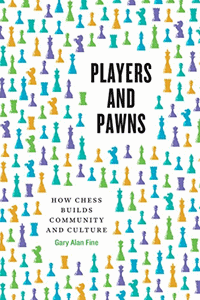'Players and Pawns'
Since starting this series on The Sociology of Chess (November 2016), I've struggled with one glaring problem -- I know almost nothing about sociology. Even worse, I belong to that group of people who question if it's even a science. A few months ago, in Chess and the Behavioral Sciences (October 2018), I featured a video by a recognized expert who has published many works on different aspects of sociology. This was accompanied by an admission of failure on my part:-
I still haven't introduced what appears to be the most important work related to the subject, 'Players and Pawns' (uchicago.edu), by Gary Alan Fine, subtitled 'How Chess Builds Community and Culture'.
What's stopped me from delving into the book is the fear that it might be completely over my head, filled with jargon accessible only to specialists.

Chess jargon is one thing; scientific jargon is another. The softer the science, the more vulnearable it is to jargon. Is there another science as soft as sociology? How can I determine whether or not the book is accessible to a novice like me?
One approach is to gather as many available excerpts as possible, spend some time with them, then decide whether it is worth the time to investigate the book at a deeper level. Without too much trouble, I located three sources of extensive excerpts for Fine's 'Players and Pawns: How Chess Builds Community and Culture':-
- Amazon.com; 'Hardcover -- August 6, 2015'
- Google Books
- Scribd.com
In the book's introduction, titled 'First Moves', the author writes,
This book has two distinctions, neither of which may prove to be much of a recommendation. First, this is the first volume that claims the sociology of chess as its subject matter. My goal is not to psychoanalyze chess players, to examine the politics of chess, or to critique the literature on chess, but to see chess as a system -- actually several systems -- of activity: a social world with history, rules, practices, emotions, status, power, organization, and boundaries. By "social world" I refer to a community that is meaningful for its participants, that provides a social order, and that permits a sense of self and a public identity. [...]
The second distinction is that this book is arguably written by the weakest player who has ever spent years analyzing the world of chess: a patzer among patzers, a fish in a school of sharks, a committed pencil pusher but not a dedicated wood pusher. As the head of Boston's Boylston Chess Club explained to me, "A tournament player is a chess player. Someone who plays with his family or on long vacation trips is not a chess player." To be a chess player is to participate in the chess community. By this measure, I am not a chess player but at best a tourist.
That's certainly accessible. So was the rest of what I read. Near the end of the book, in a chapter titled 'Acknowledgments', I learned that 'Portions of this manuscript have appeared in other forms':-
Gary Alan Fine, "Time to Play: The Temporal Organization of Chess Competition," Time & Society 21(2012): 395-416;
Gary Alan Fine, "Sticky Cultures: Memory Publics and Communal Pasts in Competitive Chess," Cultural Sociology 7 (2013); 395-414;
Antony J. Puddephatt and Gary Alan Fine, 'Chess as Art, Science, and Sport," in 'A Companion to Sport', ed. David Andrews and Ben Carrington (Oxford: Wiley Blackwell, 2013), 390-404; and
Gary Alan Fine, 'The Mind, the Body, and the Soul of Chess; American Journal of Play 6 (2014): 321-44.
I found several of those references available in full on the web. If they are as accessible as what I've already seen -- and I have no reason to believe they're not -- I'll order a copy of the book. Expect more about that in a future post.




No comments:
Post a Comment